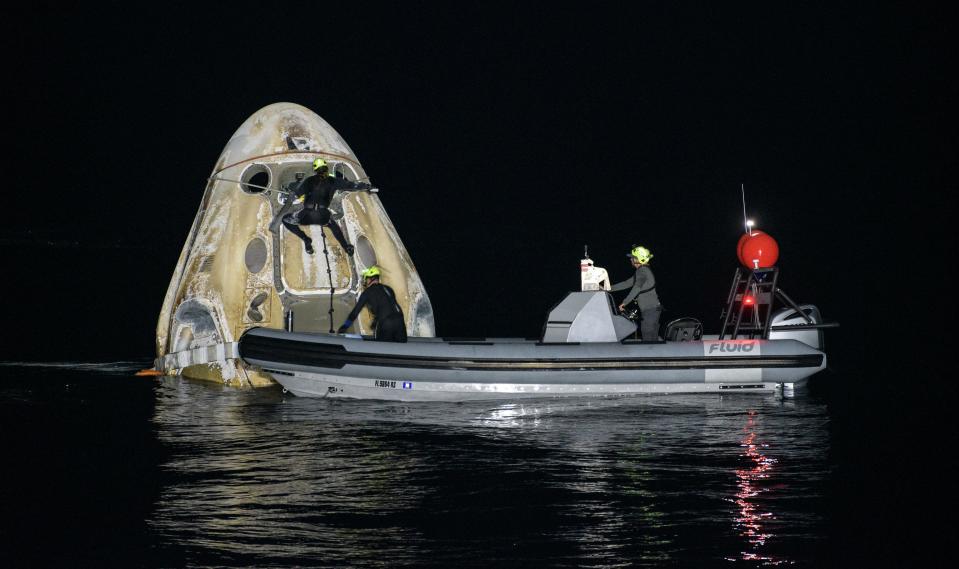Safety panel: NASA needs to develop plan for managing risk as the space industry expands
Who gets to decide what's too much risk when it comes to human spaceflight?
That is a question NASA and its partners SpaceX and Boeing need to hash out, according to a new report from the agency's independent safety panel.
For most of its existence, NASA had the first, last and only word when it came to safety. But with the agency now paying SpaceX — and eventually Boeing — to ferry its astronauts to the International Space Station using spacecraft designed and owned by those companies, the situation has changed.
NASA is now at an "inflection point," according to the annual report from the agency's Aerospace Safety Advisory Panel, or ASAP.
"As NASA looks to the future and moves to expand human knowledge and operational capabilities beyond (low-Earth orbit), it must recognize and adapt to the new environment and decide strategically how to forge humanity’s path outward while managing the risks in an appropriate manner," the 2021 report reads.
The report points to the nighttime splashdown of Crew Dragon capsule at the end of last year's Crew-1 mission, SpaceX's first fully operational flight to the ISS, as an example of the "dissonance" between the agency and Elon Musk's company.
Night splashdowns are rare occurrences for NASA, with the last one being Apollo 8 in 1968.
According to the report, NASA believed that a daytime touchdown was the lowest-risk option, while SpaceX believed nighttime landings were allowed within the mission parameters, noting that weather for splashdowns are often better at night.

That was the case last May when Crew-1 was returning from the ISS with forecasts predicting optimal weather for a night splashdown but dicey conditions predicted for the day.
NASA had to approve the nighttime splashdown at the last minute.
More: NASA and SpaceX Crew-1 astronauts safely splash down off Florida coast
"Last-minute communications and decisions made under these circumstances could have resulted in a poor decision, due to immense operational pressures," the report said. "NASA and SpaceX should have had a common understanding of relative risk levels and of the lines of communication and authority well before the mission — and certainly before a last-minute NASA approval was needed for the landing plans."
The report also points to problems with Boeing's Starliner crew capsule as an example of how NASA and private companies assess risk. Starliner is the Boeing capsule that is supposed to complement SpaceX's Crew Dragon as a vehicle to carry NASA astronauts to the ISS.
More: Boeing Starliner back at factory to diagnose and fix the propulsion system valves
Its initial uncrewed test flight in December 2019 failed to reach the ISS because of software problems. Prior to a second test flight set for last July, it came to light during that several propulsion valves on the capsule were stuck in the wrong position. Boeing deemed the situation "low-risk" while NASA considered it a "moderate risk."
Boeing rolled the rocket back to the pad and sent the capsule back to the factory to work on the problem. The company is expected to try another test flight on a United Launch Alliance Atlas V rocket no earlier than May.
"While the ultimate decision was to troubleshoot the stuck valves, the FRR revealed NASA and Boeing do not share a common understanding of how to assess and characterize risk," the report says. "Equally disturbing was that the program got very close to launching the spacecraft before the stuck-valve issue was identified."
A Boeing spokesperson said it was not unusual to have differences in risk scoring, and added that is not a bad thing.
"Using different assessments can be healthy for the program as it allows management to better understand the total level of risk as the scoring systems look through different lenses to ultimately drive down risk and increase crew safety," the spokesperson said in an emailed statement.
Neither NASA nor SpaceX responded to requests for comments for this story.
The safety panel recommended that NASA plan now for dealing with a changing space industry.
"NASA should develop a strategic vision for the future of space exploration and operations that encompasses at least the next twenty years, including potential alternative scenarios, that is driven by how the Agency is going to understand and manage risk in the more complex environment in which it will be operating," the report said.
A 25+ year veteran of FLORIDA TODAY, John McCarthy currently oversees the space team and special projects. Support quality local journalism by subscribing to FLORIDA TODAY. You can contact McCarthy at 321-752-5018 or jmccarthy@floridatoday.com.
This article originally appeared on Florida Today: NASA needs to rethink how it manages risk, new report says

